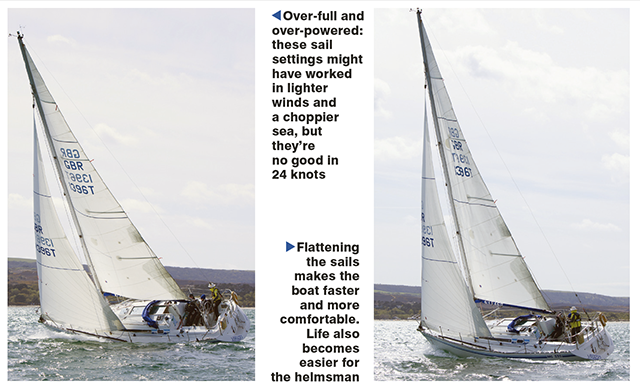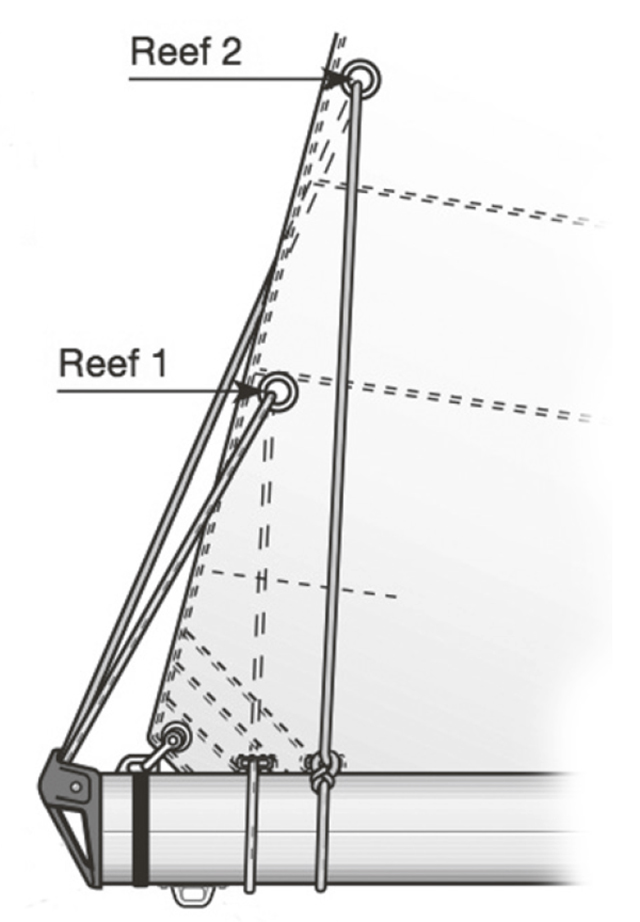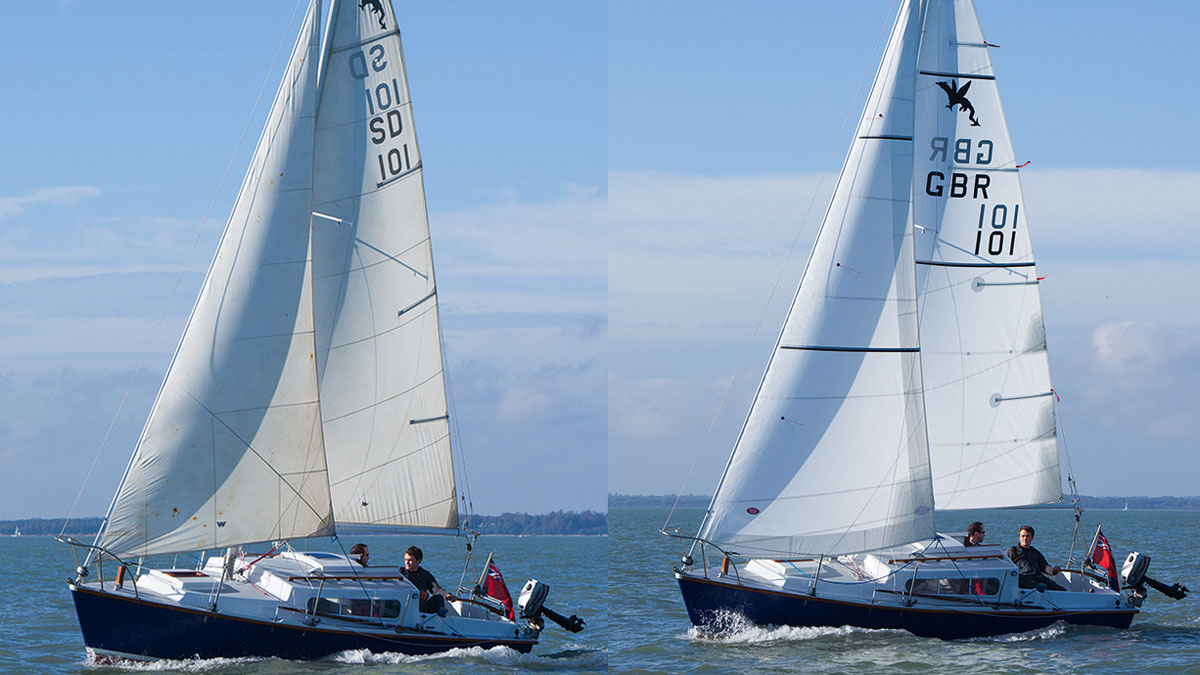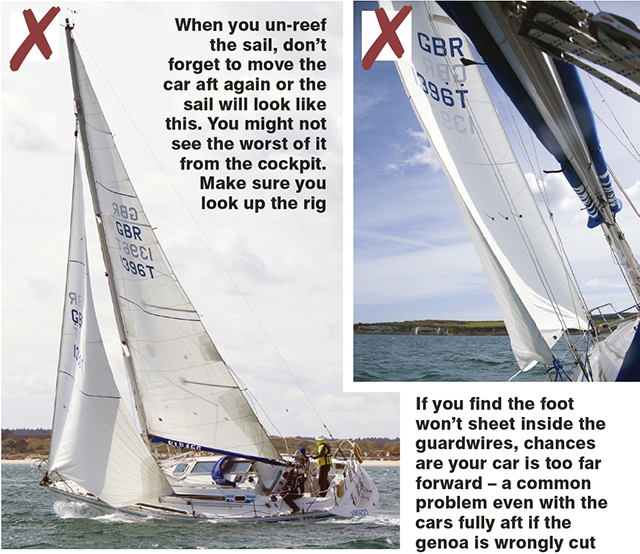David Harding explains how to reef efficiently on a yacht rigged with a roller-reefing headsail and slab-reefing mainsail
It’s a familiar situation: we’re sailing along in a breeze that picks up to the point where we start to think about reefing. By the time it reaches the ‘we really need to do something’ stage, things have got a lot tougher for the boat.
Unless we’re close to a weather shore, bigger waves will be slowing us down. Less speed, more pitching and more heel mean the keel is generating less lift. More forestay sag will be making the headsail fuller just when we don’t want it to be. If weather helm develops, we will be using more rudder angle to maintain our course, further increasing drag. And so it goes on.
Once we have reefed, the top of the rig is contributing nothing but weight, windage, heel and pitching moment: we can’t reef the mast. The windage of the hull, superstructure, sprayhood and dodgers becomes greater in relation to our sail area. If we roll our headsail it will lose much of its shape. The hill we’re climbing has become steeper, yet we have less power with which to climb it.
In a situation like this, we need to make best use of the power we have at our disposal. More’s the pity, then, that so many cruisers can be seen labouring upwind in a breeze with sails that have been rolled and pulled into all sorts of horrible shapes. That some boats succeed in making to windward at all is despite what the crew is doing, not because of it.
Like many aspects of sailing, reefing efficiently is no more difficult than reefing badly. It’s just a matter of knowing what to do.
How to rig a spinnaker on a small yacht – what you need and where to fit it
If you want a spinnaker, but don’t have the necessary fittings or equipment on your boat, where do you start?…
Why won’t my boat tack properly?
David Harding offers ideas to help a Kelt 5.50 that won't beat upwind
What difference do new sails make?
New sails are a big investment – but are they worth it? The PBO team compared the old with the…
Cruising chute or spinnaker? We compare both sails on the same boat on different points of sail
Many cruising sailors favour a cruising chute over a spinnaker – but how do the two sails compare on different…
Do you need to reef?
The first question to ask is whether you need to reef at all. If you don’t have far to go, or you’re soon going to be bearing away to bring the wind abaft the beam, you might be able to save yourself the trouble by flattening the sails rather than reefing them. In any event, as the wind picks up you should start progressively depowering the rig: increase halyard tension on both sails, use the Cunningham, flatten the mainsail’s foot with the clew outhaul, wind down the backstay, drop the traveller down the track and move the genoa car aft a hole or two (or the equivalent) to flatten the foot and twist open the top.
This is the equivalent of changing down a gear when you go up a hill. Unless the wind has increased dramatically there’s no point in going straight from sails that are over-full to sails that are reefed, missing out the stages in between.
These two photos show the difference that simply flattening the sails can make.

Caption: Flattening the sails makes the boat faster and more comfortable when the wind strength increases.
Which sail should I reef first?
Which sail you reef first can make a big difference. If taking a few rolls in your headsail leaves it with the aerodynamic qualities of a flour sack, it makes sense to start by tucking a slab in the mainsail. If, on the other hand, your boat goes best under full main and reefed headsail, there’s your answer.
Large genoas on masthead-rigged boats from the 1970s and 1980s will often lose much of their shape when reefed, so it can be best to reduce the mainsail first. By comparison, newer designs are more likely to have fractional rigs, smaller headsails and mainsails that can be flattened more effectively and left un-reefed for longer.
Should you have a self-tacking jib, however, the sheeting angle might go awry once a few rolls are taken around the headfoil – and you can’t slide a car aft along a track – so self-tackers are often best left un-reefed.
Maintaining headsail geometry
When you reef the headsail around the headfoil, make sure you maintain the correct sheeting angle by moving the car forward on the track if necessary. If your headsail is of low aspect ratio and cut with a high clew, it’s possible that the geometry won’t change and there will be no need to move the car.
With most sails, however, the car has to go forward. If it doesn’t, the sheet will be pulling too far aft, exerting insufficient downward pull on the leech so the upper part of the sail will lose its drive.
REEFING THE HEADSAIL
Car too far aft
Car too far forward
Towing cars
You can reef a roller-reefing headsail from the cockpit, but changing the sheeting angle means going on deck unless the cars are controlled by a purchase led aft rather than by plungers. If you have reef markers along the foot of the headsail, make a note of how each one corresponds to the car position. Once you have moved the working (leeward) car, don’t forget the other one as well.
It’s much easier to move it on the windward side, before you tack.
Car correctly positioned
The roller-reefing compromise
A headsail is compromised as soon as you reef it around a headfoil. That’s why it can be worthwhile using a smaller sail when you know you’re going to be making upwind for any distance in breezier conditions. Just look at the difference.
 Reefing the mainsail
Reefing the mainsail
For a reefed sail to set properly, the leech pennants need to be correctly roven. How you attach the pennants to the boom depends on whether the sail is loose-footed or set in a track, but what matters is that they’re in the right place and properly tensioned.

The ends of the reef pennants need to be secured tightly around the boom so they’re slightly abaft the cringle in the leech
Pennant too loose
Pennant too far forward
Pennant in the right position
Tidying up the bunt
If you want to tidy up the bunt (the redundant part of the sail), first make sure that the ties don’t distort the foot. All the load should be taken by the cringles at luff and leech. The reef points in between are not designed to take any weight. If they do, you risk stretching the sail or even ripping it.
Using lightweight shock-cord for the bunt is not a bad idea. If you secure it with something strong and then a leech pennant breaks or is released by mistake (someone opens the wrong clutch, for example), all the load comes on the reef points and you will have a torn sail.
Thanks to Victor and Sarah Budden for making their MG 335 Virago available for this feature, to Neil for pulling the strings and to Gino for driving the RIB
How to rig a spinnaker on a small yacht – what you need and where to fit it
If you want a spinnaker, but don’t have the necessary fittings or equipment on your boat, where do you start?…
Why won’t my boat tack properly?
David Harding offers ideas to help a Kelt 5.50 that won't beat upwind
What difference do new sails make?
New sails are a big investment – but are they worth it? The PBO team compared the old with the…
Cruising chute or spinnaker? We compare both sails on the same boat on different points of sail
Many cruising sailors favour a cruising chute over a spinnaker – but how do the two sails compare on different…
Want to read more practical articles?

A subscription to Practical Boat Owner magazine costs around 40% less than the cover price.
Print and digital editions are available through Magazines Direct – where you can also find the latest deals.
PBO is packed with information to help you get the most from boat ownership – whether sail or power.
-
-
-
- Take your DIY skills to the next level with trusted advice on boat maintenance and repairs
- Impartial in-depth gear reviews
- Practical cruising tips for making the most of your time afloat
-
-
Follow us on Facebook, Instagram, TikTok and Twitter





















